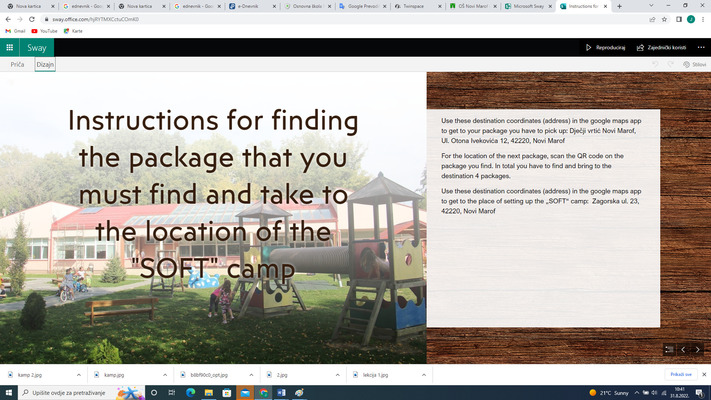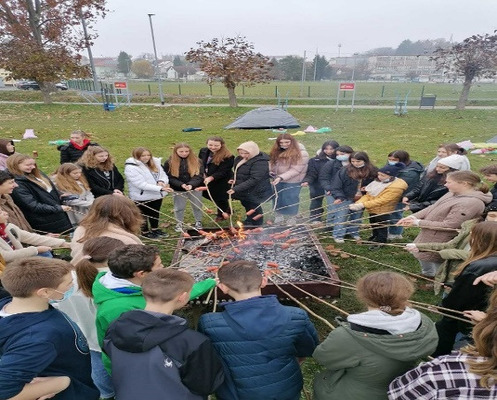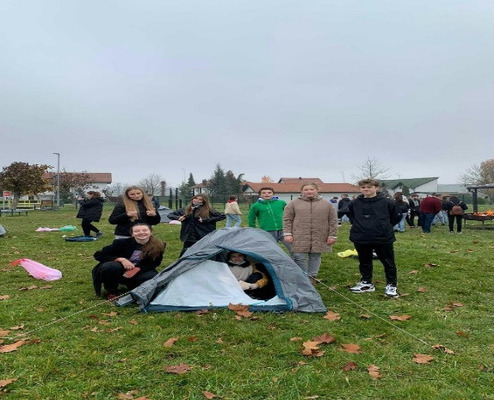Topic: Programming: Algorithm and flowchart through Outdoor learning methodolgy
Students age: 5th – 8th Grade
Number of hours: 5 school hours
Author: Josip Beštek, Novi Marof Primary School, Novi Marof, Croatia
SHORT DESCRIPTION:
During the activity, classes will be combined in the IT classroom, the school yard and the school's immediate surroundings. The activity is suitable for performance during the last days of school, summer schools or days scheduled for holding extracurricular activities.
Computer programs are programmed to perform algorithms. Human everyday actions can also be described by algorithms. Each algorithm can be described by programming commands in a programming language, which can result in computer programs that will help people in their daily tasks. Students will learn what an algorithm is and a flowchart of everyday human activities through a fun task of setting up a camp by following a given flowchart. Using QR codes and an orientation application, students will follow the instructions of the given algorithm and flow chart, and by completing all the given steps of the descriptive task, they will see the application of what they have learned in real life.
Learning objectives:
- Students collaborate with other students in carrying out the assigned task while developing collaborative relationships within the group;
- Students use creativity to shape their ideas and approaches to problem solving.
- Students adopt computational thinking skills in real life
- Students acquire important skills to help survive in nature in case of danger with the help of technology (training and/or development of orientation skills on the map and in the field; recognition of cardinal points; how to set up a shelter in nature, light the fire and prepare food)
Process:
What is an algorithm?
Explain to the students what the word algorithm means and that we encounter algorithms in various situations in our everyday life, give a few simple examples.
Encourage students to think and get them to find some more examples from everyday life in which we recognize an algorithm.
Explain to the students that depending on the way the instructions are arranged, three basic structures can be used in the algorithm: the algorithmic structure of the sequence, the algorithmic structure of branching and the algorithmic structure of repetition.
How can we show the algorithm?
Explain to the students that the algorithm can be represented graphically, using the words of a spoken language (pseudolanguage) or commands of a programming language.
Explain to the students what a flowchart is and that for its creation we use internationally agreed graphic symbols that do not depend on the spoken language.

Through talking with students, bring them to a conclusion about the advantages of using flowcharts.
Descriptions of activities for students:
Preparation for carrying out activities:
- Placement of packages that student teams must find by the teacher with the help of selected students or school colleagues: 4 packages that contain the necessary things (tent building material and tools, water, wood and fire tools, food)
- QR codes that will contain the locations of the packages that students must find.
Task for students
Today's task is to create a project "SOFT" camp in nature at the selected location. Each team has its own field in which to set up camp according to the instructions given by the flow chart.
You will make the camp using the materials you will find while playing scavenger hunt quests in different locations of the small town of Novi Marof.
Each team must find 4 packages that contain the necessary things (tent building material and tools, water, wood and fire tools, food) to setup the camp at four different locations and take them to the camp site. To search, use the Google Maps app, hiking mode. Read the location of the first package with the first QR code. When you find a package at a given location using a QR reader, you will get the coordinates of the next package.
The teams that is the first to complete the task will be rewarded😀.Coordinates of the starting point of the search and the place for picking up the "SOFT" camp:

Proofs:
Photos



Links:
https://sway.office.com/hjRYTMXCctuCOmK0?ref=Link
https://sway.office.com/jndG1etCqVbwPrcG?ref=Link
https://sway.office.com/WN1GH3dn9jrhjJdt?ref=Link
https://www.qr-code-generator.com/
https://www.diagrameditor.com/